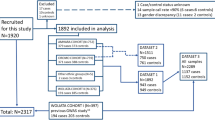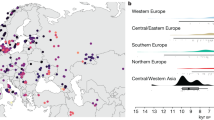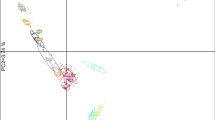Abstract
The recent feasibility of genome-wide studies of adaptation in human populations has provided novel insights into biological pathways that have been affected by adaptive pressures. However, only a few African populations have been investigated using these genome-wide approaches. Here, we performed a genome-wide analysis for evidence of recent positive selection in a sample of 120 individuals of Wolaita ethnicity belonging to Omotic-speaking people who have inhabited the mid- and high-land areas of southern Ethiopia for millennia. Using the 11 HapMap populations as the comparison group, we found Wolaita-specific signals of recent positive selection in several human leukocyte antigen (HLA) loci. Notably, the selected loci overlapped with HLA regions that we previously reported to be associated with podoconiosis–a geochemical lymphedema of the lower legs common in the Wolaita area. We found selection signals in PPARA, a gene involved in energy metabolism during prolonged food deficiency. This finding is consistent with the dietary use of enset, a crop with high-carbohydrate and low-fat and -protein contents domesticated in Ethiopia subsequent to food deprivation 10 000 years ago, and with metabolic adaptation to high-altitude hypoxia. We observed novel selection signals in CDKAL1 and NEGR1, well-known diabetes and obesity susceptibility genes. Finally, the SLC24A5 gene locus known to be associated with skin pigmentation was in the top selection signals in the Wolaita, and the alleles of single-nucleotide polymorphisms rs1426654 and rs1834640 (SLC24A5) associated with light skin pigmentation in Eurasian populations were of high frequency (47.9%) in this Omotic-speaking indigenous Ethiopian population.
Similar content being viewed by others
Log in or create a free account to read this content
Gain free access to this article, as well as selected content from this journal and more on nature.com
or
References
Pickrell JK, Coop G, Novembre J et al: Signals of recent positive selection in a worldwide sample of human populations. Genome Res 2009; 19: 826–837.
Klimentidis YC, Abrams M, Wang J, Fernandez JR, Allison DB : Natural selection at genomic regions associated with obesity and type-2 diabetes: East Asians and sub-Saharan Africans exhibit high levels of differentiation at type-2 diabetes regions. Hum Genet 2011; 129: 407–418.
Guinan KJ : Worldwide distribution of type II diabetes-associated TCF7L2 SNPs: evidence for stratification in Europe. Biochem Genet 2012; 50: 159–179.
Hamblin MT, Di Rienzo A : Detection of the signature of natural selection in humans: evidence from the Duffy blood group locus. Am J Hum Genet 2000; 66: 1669–1679.
Tishkoff SA, Reed FA, Ranciaro A et al: Convergent adaptation of human lactase persistence in Africa and Europe. Nat Genet 2007; 39: 31–40.
Ayodo G, Price AL, Keinan A et al: Combining evidence of natural selection with association analysis increases power to detect malaria-resistance variants. Am J Hum Genet 2007; 81: 234–242.
Grossman SR, Andersen KG, Shlyakhter I et al: Identifying recent adaptations in large-scale genomic data. Cell 2013; 152: 703–713.
Karlsson EK, Kwiatkowski DP, Sabeti PC : Natural selection and infectious disease in human populations. Nat Rev Genet 2014; 15: 379–393.
Akey JM : Constructing genomic maps of positive selection in humans: where do we go from here? Genome Res 2009; 19: 711–722.
Campbell MC, Tishkoff SA : African genetic diversity: implications for human demographic history, modern human origins, and complex disease mapping. Annu Rev Genomics Hum Genet 2008; 9: 403–433.
Tekola-Ayele F, Adeyemo A, Aseffa A et al: Clinical and pharmacogenomic implications of genetic variation in a Southern Ethiopian population. Pharmacogenomics J 2014, e-pub ahead of print 29 July 2014 doi:10.1038/tpj.2014.39.
Tekola Ayele F, Adeyemo A, Finan C et al: HLA class II locus and susceptibility to podoconiosis. N Engl J Med 2012; 366: 1200–1208.
Altshuler DM, Gibbs RA, Peltonen L et al: Integrating common and rare genetic variation in diverse human populations. Nature 2010; 467: 52–58.
Voight BF, Kudaravalli S, Wen X, Pritchard JK : A map of recent positive selection in the human genome. PLoS Biol 2006; 4: e72.
Sabeti PC, Varilly P, Fry B et al: Genome-wide detection and characterization of positive selection in human populations. Nature 2007; 449: 913–918.
Scheet P, Stephens M : A fast and flexible statistical model for large-scale population genotype data: applications to inferring missing genotypes and haplotypic phase. Am J Hum Genet 2006; 78: 629–644.
Andres AM, Clark AG, Shimmin L, Boerwinkle E, Sing CF, Hixson JE : Understanding the accuracy of statistical haplotype inference with sequence data of known phase. Genet Epidemiol 2007; 31: 659–671.
Reynolds J, Weir BS, Cockerham CC : Estimation of the coancestry coefficient: basis for a short-term genetic distance. Genetics 1983; 105: 767–779.
Wagh K, Bhatia A, Alexe G et al: Lactase persistence and lipid pathway selection in the Maasai. PLoS One 2012; 7: e44751.
Mi H, Muruganujan A, Thomas PD : PANTHER in 2013: modeling the evolution of gene function, and other gene attributes, in the context of phylogenetic trees. Nucleic Acids Res 2013; 41: D377–D386.
Scheinfeldt LB, Soi S, Thompson S et al: Genetic adaptation to high altitude in the Ethiopian highlands. Genome Biol 2012; 13: R1.
Liu X, Ong RT, Pillai EN et al: Detecting and characterizing genomic signatures of positive selection in global populations. Am J Hum Genet 2013; 92: 866–881.
Ong RT, Liu X, Poh WT, Sim X, Chia KS, Teo YY : A method for identifying haplotypes carrying the causative allele in positive natural selection and genome-wide association studies. Bioinformatics 2011; 27: 822–828.
Morris AP, Voight BF, Teslovich TM et al: Large-scale association analysis provides insights into the genetic architecture and pathophysiology of type 2 diabetes. Nat Genet 2012; 44: 981–990.
Saxena R, Elbers CC, Guo Y et al: Large-scale gene-centric meta-analysis across 39 studies identifies type 2 diabetes loci. Am J Hum Genet 2012; 90: 410–425.
Barreiro LB, Laval G, Quach H, Patin E, Quintana-Murci L : Natural selection has driven population differentiation in modern humans. Nat Genet 2008; 40: 340–345.
Jarvis JP, Scheinfeldt LB, Soi S et al: Patterns of ancestry, signatures of natural selection, and genetic association with stature in Western African pygmies. PLoS Genet 2012; 8: e1002641.
Williamson SH, Hubisz MJ, Clark AG, Payseur BA, Bustamante CD, Nielsen R : Localizing recent adaptive evolution in the human genome. PLoS Genet 2007; 3: e90.
Cao K, Moormann AM, Lyke KE et al: Differentiation between African populations is evidenced by the diversity of alleles and haplotypes of HLA class I loci. Tissue Antigens 2004; 63: 293–325.
Bhatia G, Patterson N, Pasaniuc B et al: Genome-wide comparison of African-ancestry populations from CARe and other cohorts reveals signals of natural selection. Am J Hum Genet 2011; 89: 368–381.
Barreiro LB, Quintana-Murci L : From evolutionary genetics to human immunology: how selection shapes host defence genes. Nat Rev Genet 2010; 11: 17–30.
Bubb KL, Bovee D, Buckley D et al: Scan of human genome reveals no new Loci under ancient balancing selection. Genetics 2006; 173: 2165–2177.
DeGiorgio M, Lohmueller KE, Nielsen R : A model-based approach for identifying signatures of ancient balancing selection in genetic data. PLoS Genet 2014; 10: e1004561.
Solberg OD, Mack SJ, Lancaster AK et al: Balancing selection and heterogeneity across the classical human leukocyte antigen loci: a meta-analytic review of 497 population studies. Hum Immunol 2008; 69: 443–464.
Andres AM, Hubisz MJ, Indap A et al: Targets of balancing selection in the human genome. Mol Biol Evol 2009; 26: 2755–2764.
Prugnolle F, Manica A, Charpentier M, Guegan JF, Guernier V, Balloux F : Pathogen-driven selection and worldwide HLA class I diversity. Curr Biol 2005; 15: 1022–1027.
Sanchez-Mazas A, Lemaitre JF, Currat M : Distinct evolutionary strategies of human leucocyte antigen loci in pathogen-rich environments. Philos Trans R Soc Lond B Biol Sci 2012; 367: 830–839.
Dunn RR, Davies TJ, Harris NC, Gavin MC : Global drivers of human pathogen richness and prevalence. Proc Biol Sci 2010; 277: 2587–2595.
Henze PB : Layers of Time: A History of Ethiopia. London: Palgrave Macmillan, 2004.
Okada Y, Kubo M, Ohmiya H et al: Common variants at CDKAL1 and KLF9 are associated with body mass index in east Asian populations. Nat Genet 2012; 44: 302–306.
Kwak SH, Choi SH, Jung HS et al: Clinical and genetic risk factors for type 2 diabetes at early or late post partum after gestational diabetes mellitus. J Clin Endocrinol Metab 2013; 98: E744–E752.
Ng MC, Saxena R, Li J et al: Transferability and fine mapping of type 2 diabetes loci in African Americans: the Candidate Gene Association Resource Plus Study. Diabetes 2013; 62: 965–976.
Pascoe L, Tura A, Patel SK et al: Common variants of the novel type 2 diabetes genes CDKAL1 and HHEX/IDE are associated with decreased pancreatic beta-cell function. Diabetes 2007; 56: 3101–3104.
Ubeda M, Rukstalis JM, Habener JF : Inhibition of cyclin-dependent kinase 5 activity protects pancreatic beta cells from glucotoxicity. J Biol Chem 2006; 281: 28858–28864.
Wei FY, Nagashima K, Ohshima T et al: Cdk5-dependent regulation of glucose-stimulated insulin secretion. Nat Med 2005; 11: 1104–1108.
Steinthorsdottir V, Thorleifsson G, Reynisdottir I et al: A variant in CDKAL1 influences insulin response and risk of type 2 diabetes. Nat Genet 2007; 39: 770–775.
Prentice AM, Hennig BJ, Fulford AJ : Evolutionary origins of the obesity epidemic: natural selection of thrifty genes or genetic drift following predation release? Int J Obes (Lond) 2008; 32: 1607–1610.
Nakayama K, Ogawa A, Miyashita H et al: Positive natural selection of TRIB2, a novel gene that influences visceral fat accumulation, in East Asia. Hum Genet 2013; 132: 201–217.
Lefebvre P, Chinetti G, Fruchart JC, Staels B : Sorting out the roles of PPAR alpha in energy metabolism and vascular homeostasis. J Clin Invest 2006; 116: 571–580.
Kersten S, Seydoux J, Peters JM, Gonzalez FJ, Desvergne B, Wahli W : Peroxisome proliferator-activated receptor alpha mediates the adaptive response to fasting. J Clin Invest 1999; 103: 1489–1498.
Hashimoto T, Cook WS, Qi C, Yeldandi AV, Reddy JK, Rao MS : Defect in peroxisome proliferator-activated receptor alpha-inducible fatty acid oxidation determines the severity of hepatic steatosis in response to fasting. J Biol Chem 2000; 275: 28918–28928.
Leone TC, Weinheimer CJ, Kelly DP : A critical role for the peroxisome proliferator-activated receptor alpha (PPARalpha) in the cellular fasting response: the PPARalpha-null mouse as a model of fatty acid oxidation disorders. Proc Natl Acad Sci USA 1999; 96: 7473–7478.
Reddy JK, Hashimoto T : Peroxisomal beta-oxidation and peroxisome proliferator-activated receptor alpha: an adaptive metabolic system. Annu Rev Nutr 2001; 21: 193–230.
Brandt SA, Spring A, Hiebsch C et al: The "Tree Against Hunger". Enset-based Agricultural Systems in Ethiopia. Washington, DC: American Association for the Advancement of Science, 1997.
Ehret C : On the antiquity of agriculture in Ethiopia. J Afr Hist 1979; 20: 161–177.
Ge RL, Simonson TS, Cooksey RC et al: Metabolic insight into mechanisms of high-altitude adaptation in Tibetans. Mol Genet Metab 2012; 106: 244–247.
Simonson TS, Yang Y, Huff CD et al: Genetic evidence for high-altitude adaptation in Tibet. Science 2010; 329: 72–75.
Shin MJ, Kanaya AM, Krauss RM : Polymorphisms in the peroxisome proliferator activated receptor alpha gene are associated with levels of apolipoprotein CIII and triglyceride in African-Americans but not Caucasians. Atherosclerosis 2008; 198: 313–319.
Kimura R, Takahashi N, Murota K et al: Activation of peroxisome proliferator-activated receptor-alpha (PPARalpha) suppresses postprandial lipidemia through fatty acid oxidation in enterocytes. Biochem Biophys Res Commun 2011; 410: 1–6.
Tesfaye F : Epidemiology of Cardiovascular Disease Risk Factors in Ethiopia: The rural–urban gradient, PhD thesis Umea: Umeå University, 2008.
Misganaw A, Mariam DH, Araya T, Ayele K : Patterns of mortality in public and private hospitals of Addis Ababa, Ethiopia. BMC Public Health 2012; 12: 1007.
Pagani L, Kivisild T, Tarekegn A et al: Ethiopian genetic diversity reveals linguistic stratification and complex influences on the Ethiopian gene pool. Am J Hum Genet 2012; 91: 83–96.
Beleza S, Santos AM, McEvoy B et al: The timing of pigmentation lightening in Europeans. Mol Biol Evol 2013; 30: 24–35.
Raj T, Kuchroo M, Replogle JM, Raychaudhuri S, Stranger BE, De Jager PL : Common risk alleles for inflammatory diseases are targets of recent positive selection. Am J Hum Genet 2013; 92: 517–529.
Yakob B, Deribe K, Davey G : High levels of misconceptions and stigma in a community highly endemic for podoconiosis in southern Ethiopia. Trans R Soc Trop Med Hyg 2008; 102: 439–444.
Tora A, Davey G, Tadele G : A qualitative study on stigma and coping strategies of patients with podoconiosis in Wolaita zone, Southern Ethiopia. Int Health 2011; 3: 176–181.
Tekola F, Bull S, Farsides B et al: Impact of social stigma on the process of obtaining informed consent for genetic research on podoconiosis: a qualitative study. BMC Med Ethics 2009; 10: 13.
Acknowledgements
The research project was supported by the Wellcome Trust (grant #079791), and the Intramural Research Program of the National Human Genome Research Institute, National Institutes of Health, in the Center for Research on Genomics and Global Health (CRGGH). The CRGGH is also supported by the National Institute of Diabetes and Digestive and Kidney Diseases. The funders had no role in study design, data collection and analysis, decision to publish or preparation of the manuscript. We thank staff of the Mossy Foot Treatment and Prevention Association (now Mossy Foot International) for coordinating the fieldwork.
Author information
Authors and Affiliations
Corresponding author
Ethics declarations
Competing interests
The authors declare no conflict of interest.
Additional information
Supplementary Information accompanies this paper on European Journal of Human Genetics website
Supplementary information
Rights and permissions
About this article
Cite this article
Tekola-Ayele, F., Adeyemo, A., Chen, G. et al. Novel genomic signals of recent selection in an Ethiopian population. Eur J Hum Genet 23, 1085–1092 (2015). https://doi.org/10.1038/ejhg.2014.233
Received:
Revised:
Accepted:
Published:
Issue date:
DOI: https://doi.org/10.1038/ejhg.2014.233
This article is cited by
-
Understanding the contemporary high obesity rate from an evolutionary genetic perspective
Hereditas (2023)
-
High-altitude adaptation in humans: from genomics to integrative physiology
Journal of Molecular Medicine (2017)



